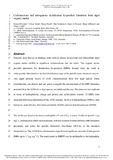JavaScript is disabled for your browser. Some features of this site may not work without it.
| dc.contributor.author | Goslan, Emma Harriet | |
| dc.contributor.author | Seigle, Céline | |
| dc.contributor.author | Purcell, Diane | |
| dc.contributor.author | Henderson, Rita Kay | |
| dc.contributor.author | Parsons, Simon A. | |
| dc.contributor.author | Jefferson, Bruce | |
| dc.contributor.author | Judd, Simon J. | |
| dc.date.accessioned | 2017-01-18T09:34:13Z | |
| dc.date.available | 2017-01-18T09:34:13Z | |
| dc.date.issued | 2016-12-10 | |
| dc.identifier.citation | Goslan EH, Seigle C, Purcell D, Henderson R, Parsons SA, Jefferson B, Judd SJ, Carbonaceous and nitrogenous disinfection by-product formation from algal organic matter, Chemosphere, Volume 170, March 2017, Pages 1–9 | en_UK |
| dc.identifier.issn | 0045-6535 | |
| dc.identifier.uri | http://dx.doi.org/10.1016/j.chemosphere.2016.11.148 | |
| dc.identifier.uri | http://dspace.lib.cranfield.ac.uk/handle/1826/11293 | |
| dc.description.abstract | Seasonal algal blooms in drinking water sources release intracellular and extracellular algal organic matter (AOM) in significant concentrations into the water. This organic matter provides precursors for disinfection by-products (DBPs) formed when the water is subsequently chlorinated at the final disinfection stage of the potable water treatment process. This paper presents results of AOM characterisation from five algal species (three cyanobacteria, one diatom and one green) alongside the measurement of the DBP formation potential from the AOM of six algal species (an additional diatom). The character was explored in terms of hydrophilicity, charge and protein and carbohydrate content. 18 DBPs were measured following chlorination of the AOM samples: the four trihalomethanes (THMs), nine haloacetic acids (HAAs), four haloacetonitriles (HANs) and one halonitromethane (HNM). The AOM was found to be mainly hydrophilic (52 and 81%) in nature. Yields of up to 92.4 μg mg−1 C carbonaceous DBPs were measured, with few consistent trends between DBP formation propensity and either the specific ultraviolet absorbance (SUVA) or the chemical characteristics. The AOM from diatomaceous algae formed significant amounts of nitrogenous DBPs (up to 1.7 μg mg−1 C). The weak trends in DBPFP may be attributable to the hydrophilic nature of AOM, which also makes it more challenging to remove by conventional water treatment processes. | en_UK |
| dc.language.iso | en | en_UK |
| dc.publisher | Elsevier | en_UK |
| dc.rights | Attribution-NonCommercial-NoDerivatives 4.0 International | |
| dc.rights.uri | http://creativecommons.org/licenses/by-nc-nd/4.0/ | |
| dc.subject | Algae | en_UK |
| dc.subject | Trihalomethanes | en_UK |
| dc.subject | Haloacetic acids | en_UK |
| dc.subject | Haloacetonitriles | en_UK |
| dc.subject | Characterisation | en_UK |
| dc.title | Carbonaceous and nitrogenous disinfection by-product formation from algal organic matter | en_UK |
| dc.type | Article | en_UK |
| dc.identifier.cris | 16264157 |
Files in this item
This item appears in the following Collection(s)
-
Staff publications (SWEE) [2825]

